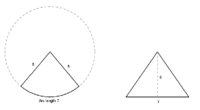These two areas are the same? It doesn't appear obvious to me why they should be? And it is a little surprising.

Algebraically, it can be seen quite easily? But can anyone help me see geometrically, why they might be? Is it even useful to think of it this way? Thinking graphically/geometrically doesn't occur naturally to me !

Algebraically, it can be seen quite easily? But can anyone help me see geometrically, why they might be? Is it even useful to think of it this way? Thinking graphically/geometrically doesn't occur naturally to me !
